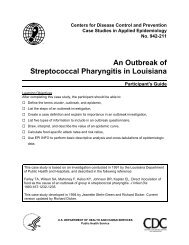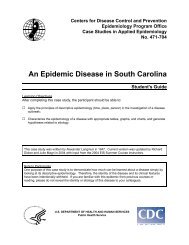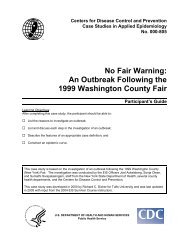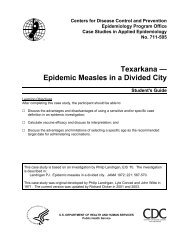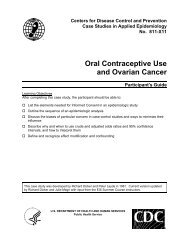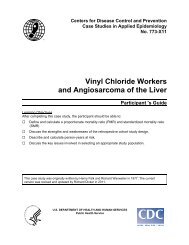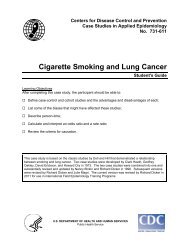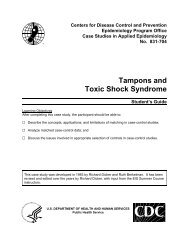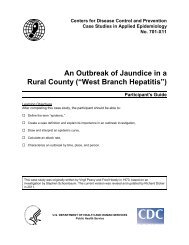C:\Case studies all\XPBBs in Michigan\Xpbb_s.813-N02.wpd - Library
C:\Case studies all\XPBBs in Michigan\Xpbb_s.813-N02.wpd - Library
C:\Case studies all\XPBBs in Michigan\Xpbb_s.813-N02.wpd - Library
Create successful ePaper yourself
Turn your PDF publications into a flip-book with our unique Google optimized e-Paper software.
Centers for Disease Control and Prevention<br />
Epidemiology Program Office<br />
Case Studies <strong>in</strong> Applied Epidemiology<br />
No. 813-N02<br />
A Mixed Bag <strong>in</strong> Michigan:<br />
The PBB Story<br />
Learn<strong>in</strong>g Objectives<br />
After complet<strong>in</strong>g this case study, the participant should be able to:<br />
Student's Guide<br />
G<br />
G<br />
G<br />
G<br />
Describe the role of each government agency <strong>in</strong>volved <strong>in</strong> a contam<strong>in</strong>ated food situation.<br />
Discuss different options for study<strong>in</strong>g the human health effects follow<strong>in</strong>g an environmental<br />
exposure.<br />
Calculate sample size requirements for a community survey.<br />
Discuss the reasons for and limitations of a registry follow<strong>in</strong>g an environmental exposure.<br />
This case study was orig<strong>in</strong>ally written by Clark Heath <strong>in</strong> 1981. It was revised by Tom Gomez<br />
and Richard Dicker <strong>in</strong> 1991. The current version was revised and updated by Richard Dicker<br />
<strong>in</strong> 2000 with <strong>in</strong>put from Dori Reissman and the other EIS Summer Course <strong>in</strong>structors.<br />
U.S. DEPARTMENT OF HEALTH AND HUMAN SERVICES<br />
Public Health Service
CDC / EIS, 2000: A Mixed Bag <strong>in</strong> Michigan (PBBs) - Student's Guide Page 2<br />
PART I<br />
In September 1973, a farmer <strong>in</strong> southwest<br />
Michigan noticed a decl<strong>in</strong>e <strong>in</strong> the feed<br />
consumption and milk production of his 400<br />
dairy cows. With<strong>in</strong> 20 days, feed consumption<br />
had dropped by about 50% and milk production<br />
had decl<strong>in</strong>ed from 13,000 lb. per day to 7,600 lb.<br />
per day. The farmer noted other cl<strong>in</strong>ical f<strong>in</strong>d<strong>in</strong>gs<br />
such as <strong>in</strong>creased ur<strong>in</strong>ation and lacrimation, but<br />
rectal temperatures rema<strong>in</strong>ed normal. Some<br />
animals developed bruises, abscesses,<br />
abnormal hoof growth, hair loss, and thicken<strong>in</strong>g<br />
of the sk<strong>in</strong>. Others developed cachexia and<br />
died with<strong>in</strong> 6 months. The farmer and his<br />
veter<strong>in</strong>arian ruled out the usual <strong>in</strong>fectious<br />
diseases, but could not establish a diagnosis.<br />
Both men suspected that someth<strong>in</strong>g was wrong<br />
with the feed. Each day, each cow was fed up<br />
to 15 lb. or more of 24%-prote<strong>in</strong> pellets, plus a<br />
mixture of alfalfa and corn silage. Because the<br />
local corn silage was low <strong>in</strong> magnesium,<br />
magnesium oxide was added to the gra<strong>in</strong><br />
mixture at the feed plant before pellet<strong>in</strong>g. The<br />
pellets were supplied by Farm Bureau Services,<br />
Michigan's largest feed distributor and a<br />
subsidiary of the state's most important farmer<br />
organization, the Michigan Farm Bureau.<br />
Question 1:<br />
What might you do to determ<strong>in</strong>e whether the feed was the cause of the herd's unusual<br />
illness?
CDC / EIS, 2000: A Mixed Bag <strong>in</strong> Michigan (PBBs) - Student's Guide Page 3<br />
PART II<br />
The Farm Bureau Services denied knowledge of<br />
any problems with the feed. Nevertheless, the<br />
farmer removed the feed from the ma<strong>in</strong> dairy<br />
farm, and took it to another farm where calves<br />
are raised. There, the farmer gave twelve 6- to<br />
18-month-old heifers and bulls a steady diet of<br />
the suspected feed pellets. After 6 weeks, 5 of<br />
the 12 animals had died. Interest<strong>in</strong>gly, rats and<br />
mice which had long been present <strong>in</strong> and<br />
around the feed storage build<strong>in</strong>g were<br />
completely eradicated. Autopsy f<strong>in</strong>d<strong>in</strong>gs of the<br />
calves consistently showed liver damage,<br />
lead<strong>in</strong>g the farmer and his veter<strong>in</strong>arian to<br />
postulate a hepatotox<strong>in</strong> as the cause of the<br />
mysterious illness.<br />
In early 1974, the feed company began its own<br />
feed<strong>in</strong>g trials and chemical analyses. In March,<br />
gas chromatography of the feed left runn<strong>in</strong>g by<br />
mistake dur<strong>in</strong>g the lunch break unexpectedly<br />
revealed the presence of an series of peaks<br />
correspond<strong>in</strong>g to the family of polybrom<strong>in</strong>ated<br />
biphenyls (PBBs). PBBs, marketed as<br />
Firemaster, were produced as a flame retardant<br />
for plastics by the Michigan Chemical<br />
Corporation (MCC). This company also sold<br />
magnesium oxide under the trade name<br />
Nutrimaster to Farm Bureau Services, which<br />
added the substance to dairy feed. Accord<strong>in</strong>g<br />
to MCC, these two products were distributed <strong>in</strong><br />
dist<strong>in</strong>ctive color-coded bags: Firemaster <strong>in</strong> bright<br />
red and Nutrimaster <strong>in</strong> bright blue.<br />
The U.S. Food and Drug Adm<strong>in</strong>istration (FDA)<br />
was notified of the PBB f<strong>in</strong>d<strong>in</strong>g on April 26, and<br />
immediately <strong>in</strong>itiated <strong>in</strong>spections of feed mills<br />
throughout the state. Four days later, an FDA<br />
<strong>in</strong>spector discovered a half-empty paper brown<br />
bag <strong>in</strong> a Michigan feed mill. Stenciled across<br />
the top of the bag was the name, Firemaster.<br />
Further discussions with MCC representatives<br />
revealed that they had run out of color-coded<br />
bags <strong>in</strong> spr<strong>in</strong>g 1973, so they used pla<strong>in</strong> brown<br />
50-lb. bags for both Firemaster and Nutrimaster.<br />
They were dist<strong>in</strong>guishable only by the name<br />
stenciled across the top. In May 1973, an<br />
estimated 10 to 15 bags of Firemaster were<br />
mistakenly shipped to feed mills as Nutrimaster.<br />
The Firemaster, similar to Nutrimaster <strong>in</strong> both<br />
consistency and color, was <strong>in</strong>corporated <strong>in</strong>to<br />
feed pellets and sold to Michigan farmers.<br />
Thus, the mix-up had gone undetected for<br />
almost a year.<br />
Question 2:<br />
Who are the stakeholders <strong>in</strong> this situation. What are their concerns? What are their<br />
responsibilities?
CDC / EIS, 2000: A Mixed Bag <strong>in</strong> Michigan (PBBs) - Student's Guide Page 4<br />
PART III<br />
Farm Bureau Services feed conta<strong>in</strong><strong>in</strong>g<br />
Nutrimaster was immediately recalled.<br />
Shipments of Michigan dairy products outside<br />
the state were halted. The Michigan<br />
Department of Agriculture began test<strong>in</strong>g animals<br />
and dairy products on farms suspected of PBB<br />
contam<strong>in</strong>ation. MCC recalled all Nutrimaster on<br />
May 2. On May 10, FDA established a farm<br />
quarant<strong>in</strong>e guidel<strong>in</strong>e of 1 part per million (ppm)<br />
PBBs (fat basis) <strong>in</strong> milk and milk products. On<br />
that same date the first farm was quarant<strong>in</strong>ed by<br />
the Michigan Department of Agriculture based<br />
on a level of 34 ppm PBBs <strong>in</strong> milk fat. On May<br />
29 and June 12, respectively, FDA established<br />
further quarant<strong>in</strong>e guidel<strong>in</strong>es of 0.3 ppm PBBs <strong>in</strong><br />
animal feeds and 1 ppm PBBs <strong>in</strong> meat fat. (In<br />
November 1974, as a result of improved<br />
laboratory technology, these guidel<strong>in</strong>es were<br />
lowered by FDA to 0.3 ppm <strong>in</strong> milk, meat,<br />
poultry, and dairy products, and 0.05 ppm <strong>in</strong><br />
eggs and <strong>in</strong> feed. In October 1977, state law<br />
further reduced the limit <strong>in</strong> milk to 20 parts per<br />
billion (equal to 0.02 ppm).<br />
The Michigan Department of Public Health<br />
(MDPH) was contacted <strong>in</strong> mid-May 1974,<br />
because of concerns regard<strong>in</strong>g possible human<br />
health problems on several of the quarant<strong>in</strong>ed<br />
farms. By that time, approximately 50 dairy and<br />
50 non-dairy farms had been quarant<strong>in</strong>ed.<br />
Question 3:<br />
Picture yourself as the Director of the Michigan Department of Public Health, charged<br />
with the responsibility for assess<strong>in</strong>g the human health impact of this chemical<br />
contam<strong>in</strong>ation problem. How might you proceed?<br />
The chemical structure of PBBs is analogous to<br />
that of polychlor<strong>in</strong>ated biphenyls (PCBs), with<br />
brom<strong>in</strong>e atoms <strong>in</strong> place of chlor<strong>in</strong>e atoms. In<br />
1974, relatively little toxicologic <strong>in</strong>formation was<br />
available regard<strong>in</strong>g PBBs, particularly their<br />
effects on human health. It was assumed,<br />
however, that PBBs might have characteristics<br />
similar to PCBs, perhaps with even greater<br />
biologic activity. A prom<strong>in</strong>ent feature of PCBs<br />
and related compounds is their marked<br />
tendency to concentrate <strong>in</strong> fat and hence to<br />
rema<strong>in</strong> <strong>in</strong> tissues for a long time. Human health<br />
effects at relatively high doses <strong>in</strong> occupational<br />
exposure sett<strong>in</strong>gs have <strong>in</strong>cluded chloracne (a<br />
dist<strong>in</strong>ctive acne-like sk<strong>in</strong> lesion), and with<br />
abnormalities <strong>in</strong> liver, kidney, and peripheral<br />
nervous system function. In rats, PCBs have<br />
been shown to produce hepatic cancer. Other<br />
animal <strong>studies</strong> have suggested that PCB<br />
exposure may produce immunologic alterations<br />
as well as fetal aberrations and abnormalities <strong>in</strong><br />
growth and development.<br />
MDPH decided its first priority was to determ<strong>in</strong>e<br />
the nature and extent of human exposure and to<br />
identify patterns of PBB-associated illness.<br />
MDPH epidemiologists, with the help of local<br />
health department staff, attempted to <strong>in</strong>terview<br />
and exam<strong>in</strong>e all family members liv<strong>in</strong>g on<br />
quarant<strong>in</strong>ed farms, plus other families identified<br />
by quarant<strong>in</strong>ed families as hav<strong>in</strong>g consumed<br />
produce directly from quarant<strong>in</strong>ed farms. They<br />
identified over 250 persons liv<strong>in</strong>g on quarant<strong>in</strong>ed<br />
farms and about 500 others who had been
CDC / EIS, 2000: A Mixed Bag <strong>in</strong> Michigan (PBBs) - Student's Guide Page 5<br />
exposed by eat<strong>in</strong>g produce from such farms. By<br />
the end of July 1974, they had conducted<br />
comprehensive health <strong>in</strong>terviews, either <strong>in</strong><br />
person or by telephone, with over 90% of both<br />
groups. In addition, they collected blood and<br />
ur<strong>in</strong>e samples for cl<strong>in</strong>ical laboratory test<strong>in</strong>g<br />
(complete blood count, cl<strong>in</strong>ical chemistries,<br />
ur<strong>in</strong>alysis) from 211 participants. Samples of<br />
blood from these participants were also banked<br />
for future analysis.<br />
No clear patterns of cl<strong>in</strong>ical illness were seen.<br />
Question 4:<br />
With these general f<strong>in</strong>d<strong>in</strong>gs <strong>in</strong> hand, what k<strong>in</strong>d of study, if any, would you do next? List<br />
and expla<strong>in</strong> your reasons for do<strong>in</strong>g whatever you propose.
CDC / EIS, 2000: A Mixed Bag <strong>in</strong> Michigan (PBBs) - Student's Guide Page 6<br />
PART IV<br />
In the fall of 1974, MDPH epidemiologists<br />
conducted a study <strong>in</strong> which they collected<br />
<strong>in</strong>terview, medical, and laboratory data from<br />
residents of quarant<strong>in</strong>ed dairy farms and from<br />
residents of an equal number of nonquarant<strong>in</strong>ed<br />
farms matched by geographic area<br />
and randomly selected from lists of dairy<br />
producers. Personal <strong>in</strong>terviews were conducted<br />
with 298 participants: 165 from 25 quarant<strong>in</strong>ed<br />
farms and 133 from 25 non-quarant<strong>in</strong>ed farms.<br />
The <strong>in</strong>terviewers collected detailed <strong>in</strong>formation<br />
regard<strong>in</strong>g environmental exposures (<strong>in</strong>clud<strong>in</strong>g<br />
PBBs) and medical history, with emphasis on<br />
changes <strong>in</strong> health s<strong>in</strong>ce mid-1973. In addition,<br />
214 participants underwent physical<br />
exam<strong>in</strong>ations, electrocardiograms, standard<br />
cl<strong>in</strong>ical laboratory tests on blood and ur<strong>in</strong>e, and<br />
measurements of serum PBB level.<br />
Question 5:<br />
What type of study is this? What are the particular strengths and potential weaknesses<br />
of this study design?<br />
Table 1 shows the serum PBB levels found <strong>in</strong> adults and children from quarant<strong>in</strong>ed and non-quarant<strong>in</strong>ed<br />
farms.<br />
Table 1. Serum PBB levels <strong>in</strong> residents of quarant<strong>in</strong>ed and non-quarant<strong>in</strong>ed farms, MDPH study, 1974<br />
Quarant<strong>in</strong>ed Farms<br />
Non-Quarant<strong>in</strong>ed Farms<br />
Adults Children Adults Children<br />
Serum PBB (ppm) # % # % # % # %<br />
CDC / EIS, 2000: A Mixed Bag <strong>in</strong> Michigan (PBBs) - Student's Guide Page 7<br />
Question 6b: What types of graphs could you use to display the data <strong>in</strong> Table 1?<br />
Question 6c: Us<strong>in</strong>g a separate sheet of paper, graph the data <strong>in</strong> Table 1.<br />
Question 6d: Describe the data <strong>in</strong> Table 1 and <strong>in</strong> your graph(s).<br />
Question 6e: What implications do these data have for future <strong>studies</strong> and for future public health<br />
action?<br />
Questionnaire responses were exam<strong>in</strong>ed for<br />
illness first occurr<strong>in</strong>g, or <strong>in</strong>tensify<strong>in</strong>g, after May<br />
1, 1973. Of 78 different health questions asked,<br />
only 6 conditions showed sufficient numbers of<br />
positive responses to permit statistical analysis.<br />
These were rash, anxiety, tiredness, headache,<br />
numbness, and balance problems.<br />
Question 7:<br />
Assum<strong>in</strong>g that none of the 78 conditions was truly associated with quarant<strong>in</strong>e status<br />
(e.g., under the null hypothesis for every condition), what is the probability that a<br />
statistically significant (p < 0.05) will be found for at least one of the 78 conditions?
CDC / EIS, 2000: A Mixed Bag <strong>in</strong> Michigan (PBBs) - Student's Guide Page 8<br />
In fact, no statistically significant differences<br />
between quarant<strong>in</strong>ed and non-quarant<strong>in</strong>ed<br />
groups were seen <strong>in</strong> frequency, severity, or<br />
duration of the 6 more common or the other<br />
72 less common conditions. The frequencies of<br />
the 6 more common conditions by serum PBB<br />
level are shown <strong>in</strong> Table 2.<br />
Table 2. Frequency of selected symptoms by serum PBB level, MDPH study, 1974<br />
Serum PBB (ppm)<br />
< 0.002 0.002 - 0.019 0.020 +<br />
Condition # % # % # %<br />
Rash Increased severity 1 4% 5 5% 4 11%<br />
Anxiety Increased severity 2 8% 6 6% 7 19%<br />
Increased frequency 2 8% 3 3% 6 16%<br />
Tiredness Increased severity 3 12.5% 6 6% 9 24%<br />
Increased frequency 3 12.5% 4 4% 9 24%<br />
Headache Increased severity 2 8% 8 8% 4 11%<br />
Increased frequency 5 21% 9 9% 6 16%<br />
Numbness Increased frequency 1 4% 2 2% 2 5%<br />
Balance Increased severity 1 4% 5 5% 5 14%<br />
Problems Increased frequency 1 4% 5 5% 4 11%<br />
Total Participants 24 100% 95 100% 37 100%<br />
Question 8:<br />
Interpret these data. What are the limitations of these data?<br />
By the end of February 1975, the Michigan<br />
Department of Agriculture had quarant<strong>in</strong>ed over<br />
300 farms, with approximately 15,500 dairy<br />
cattle, 3,500 sw<strong>in</strong>e, 500 sheep, and 1,500,000<br />
chickens. These animals, together with<br />
thousands of pounds of eggs and dairy<br />
products, were eventually destroyed. The<br />
economic problems caused by these agricultural<br />
control measures underscored public concern<br />
and uncerta<strong>in</strong>ty about the extent of the problem<br />
and its possible implications for human health.<br />
The PBB <strong>in</strong>cident became a hot political issue <strong>in</strong><br />
the race for Governor of Michigan. Such was<br />
the sett<strong>in</strong>g <strong>in</strong> which several further<br />
epidemiologic <strong>studies</strong> were developed over the<br />
next several years.<br />
With<strong>in</strong> the human body, fat serves as the largest<br />
repository for PBBs. Concentrations <strong>in</strong> fat tissue<br />
provide a reliable <strong>in</strong>dex of body burden and<br />
exposure, but require <strong>in</strong>vasive procedures.<br />
Breast milk concentrations correlate well with<br />
those <strong>in</strong> fat tissue, but can only be obta<strong>in</strong>ed from<br />
a small proportion of the population (lactat<strong>in</strong>g
CDC / EIS, 2000: A Mixed Bag <strong>in</strong> Michigan (PBBs) - Student's Guide Page 9<br />
women). Serum levels are more easily<br />
obta<strong>in</strong>ed, but correlate less well with fat tissue<br />
concentrations.<br />
The observation made <strong>in</strong> the 1974 MDPH study<br />
that persons from non-quarant<strong>in</strong>ed farms had<br />
detectable levels of serum PBBs led to efforts to<br />
def<strong>in</strong>e more clearly the extent of PBB<br />
distribution <strong>in</strong> the general population of<br />
Michigan. One group of researchers proposed<br />
to do a population-based survey to measure<br />
PBB levels <strong>in</strong> breast milk of lactat<strong>in</strong>g Michigan<br />
women.<br />
Question 9:<br />
What factors enter <strong>in</strong>to the computation of required sample size for a population-based<br />
survey?<br />
The survey was designed to yield separate<br />
estimates of detectable PBB levels <strong>in</strong> breast milk<br />
for the state's two geographically dist<strong>in</strong>ct<br />
pen<strong>in</strong>sulas, because the distribution of<br />
contam<strong>in</strong>ated animals and quarant<strong>in</strong>ed farms<br />
suggested that PBB were more widely<br />
distributed <strong>in</strong> the lower pen<strong>in</strong>sula (LP) than <strong>in</strong><br />
the upper pen<strong>in</strong>sula (UP). The estimated<br />
population of the LP <strong>in</strong> 1976 was 8,777,000; the<br />
UP estimated population was 327,000. The<br />
<strong>in</strong>vestigators judged it adequate to make<br />
pen<strong>in</strong>sula-wide <strong>in</strong>ferences us<strong>in</strong>g an 85%<br />
confidence <strong>in</strong>terval (t=1.44) with width plus or<br />
m<strong>in</strong>us 10%.<br />
Question 10a:<br />
Estimate the number of births <strong>in</strong> one week <strong>in</strong> the LP, and the number of births <strong>in</strong> one<br />
month <strong>in</strong> the upper pen<strong>in</strong>sula. Use an estimated U.S, population of 250,000,000,<br />
and roughly 3,000,000 births per year, and assume no seasonality <strong>in</strong> births. (Note:<br />
the U.S. population and number of annual births are now higher.)
CDC / EIS, 2000: A Mixed Bag <strong>in</strong> Michigan (PBBs) - Student's Guide Page 10<br />
To estimate prevalence <strong>in</strong> a large population, the formula for required sample size of a large population<br />
is:<br />
n = t 2 p(1!p) / d 2<br />
where<br />
p = guesstimated prevalence <strong>in</strong> population (use 0.5 if you don't know)<br />
t = Z-score based on desired confidence level (e.g., 1.96 for 95% confidence)<br />
d = acceptable tolerance (precision, width of confidence <strong>in</strong>terval), e.g., 10%<br />
If the population is small, so that the sample n comprises > 5% of the total population N, calculate f<strong>in</strong>al n<br />
as:<br />
n f = Nn / (N + n) where N = total population<br />
Question 10b:<br />
Calculate the required sample size for each pen<strong>in</strong>sula, assum<strong>in</strong>g that the prevalence<br />
of detectable PBBs <strong>in</strong> lactat<strong>in</strong>g women was 25%, 50%, or 75%, and us<strong>in</strong>g a lactat<strong>in</strong>g<br />
LP population of 3,000 and lactat<strong>in</strong>g UP population of 300.<br />
Question 10c: Calculate the sample size if the <strong>in</strong>vestigators had wanted a 95% confidence level (t =<br />
1.96). Ignore the f<strong>in</strong>ite population correction.<br />
Question 10d: Calculate the sample size if the <strong>in</strong>vestigators had wanted a 5% tolerance (use t =<br />
1.44). Ignore the f<strong>in</strong>ite population correction.
CDC / EIS, 2000: A Mixed Bag <strong>in</strong> Michigan (PBBs) - Student's Guide Page 11<br />
Question 10e:<br />
What do you conclude about the factors <strong>in</strong> the formula?<br />
The <strong>in</strong>vestigators, us<strong>in</strong>g slightly different values<br />
and assumptions, calculated the necessary<br />
sample sizes as 41 <strong>in</strong> the UP and 55 <strong>in</strong> the LP.<br />
They def<strong>in</strong>ed the LP population as all women<br />
who gave birth <strong>in</strong> hospitals dur<strong>in</strong>g the week of<br />
August 15-21, 1976 and who chose to<br />
breastfeed. Because of the much sparser<br />
population <strong>in</strong> the UP, the UP population was<br />
def<strong>in</strong>ed as all women who gave birth dur<strong>in</strong>g the<br />
month of August and who chose to breastfeed.<br />
"To obta<strong>in</strong> a random sample, hospitals<br />
throughout the state were asked to identify<br />
women who had given birth dur<strong>in</strong>g the study<br />
period. Post-partum women were sequentially<br />
assigned numbers as hospitals were contacted.<br />
S<strong>in</strong>ce, at the time of sampl<strong>in</strong>g, the actual<br />
number of births could not be known, a high<br />
estimate of 3400 births <strong>in</strong> the LP was derived,<br />
based on the previous year's data. Information<br />
was then collected only for women match<strong>in</strong>g<br />
330 numbers selected randomly from the<br />
<strong>in</strong>tegers 1 to 3400. The actual number of live<br />
births <strong>in</strong> the LP for the study period was found<br />
later to be 2537 (300 <strong>in</strong> the UP).<br />
"54% of women matched to random numbers<br />
decided not to breastfeed and they were not<br />
contacted aga<strong>in</strong>. An attempt was made to<br />
contact, screen, and enroll a random subset of<br />
the rema<strong>in</strong><strong>in</strong>g matched women. This random<br />
subset conta<strong>in</strong>ed 83 women; 21 were excluded<br />
because they too were not lactat<strong>in</strong>g. A further 3<br />
had stopped breastfeed<strong>in</strong>g before samples were<br />
collected. Of the 59 rema<strong>in</strong><strong>in</strong>g women, 5 could<br />
not be contacted and 1 refused to participate...<br />
"In the UP, through a similar process, a random<br />
sample of 49 lactat<strong>in</strong>g women were identified.<br />
Three could not be contacted, 4 refused to<br />
participate, and 42 provided samples..."<br />
Question 11:<br />
Calculate response rates for women <strong>in</strong> the upper and lower pen<strong>in</strong>sulas. Would you<br />
worry about biases with this study design and selection process?<br />
The results of this survey are shown <strong>in</strong> Table 4.
CDC / EIS, 2000: A Mixed Bag <strong>in</strong> Michigan (PBBs) - Student's Guide Page 12<br />
Table 4. Distribution of PBBs <strong>in</strong> human breast milk fat samples <strong>in</strong> Michigan<br />
Lower penn<strong>in</strong>sula Upper penn<strong>in</strong>sula<br />
PBB level (ppm) # % # %<br />
Non-detectable 2 3.8% 24 57.1%<br />
< 0.05 16 30.2% 15 35.7%<br />
0.05 - 0.09 17 32.1% 2 4.8%<br />
0.10 - 0.49 15 28.3% 1 2.4%<br />
0.50 - 0.99 2 3.8% 0 –<br />
1.0 and above 1 1.9% 0 –<br />
Total 53 100% 42 100%<br />
Question 12:<br />
What proportion of women <strong>in</strong> the two samples had detectable levels of PBBs <strong>in</strong> their<br />
breast milk? Assum<strong>in</strong>g these samples are representative of the two parts of Michigan,<br />
calculate a s<strong>in</strong>gle overall statewide estimate the proportion of women with detectable<br />
PBB levels.<br />
Additional <strong>studies</strong> have been conducted by the<br />
MDPH, federal agencies, and researchers. One<br />
study, started <strong>in</strong> April 1976, was a MDPH / CDC<br />
long-term follow-up study. This study focused<br />
on persons liv<strong>in</strong>g on quarant<strong>in</strong>ed farms or<br />
consum<strong>in</strong>g produce received directly from such<br />
farms, .<br />
to monitor the appearance of possible non-acute<br />
health effects <strong>in</strong> PBB-exposed <strong>in</strong>dividuals.<br />
Plans for the study gave particular emphasis on<br />
assess<strong>in</strong>g eventual patterns of cancer<br />
occurrence, especially liver cancer.<br />
Study participants <strong>in</strong>cluded:<br />
1. residents of quarant<strong>in</strong>ed farms,<br />
2. recipients of produce from quarant<strong>in</strong>ed<br />
farms,<br />
3. persons liv<strong>in</strong>g near quarant<strong>in</strong>ed farms (the<br />
"non-exposed" group from the 1974 MDPH<br />
study),<br />
4. residents of non-quarant<strong>in</strong>ed farms with low<br />
PBB levels, <strong>in</strong>clud<strong>in</strong>g recipients of produce<br />
from those farms,<br />
5. Michigan Chemical Corporation workers and<br />
their families, and<br />
6. volunteers who contacted the MDPH and<br />
requested to participate <strong>in</strong> the study.
CDC / EIS, 2000: A Mixed Bag <strong>in</strong> Michigan (PBBs) - Student's Guide Page 13<br />
Question 13:<br />
Investigators asked each potential participant to provide his / her “<strong>in</strong>formed consent”<br />
before enroll<strong>in</strong>g <strong>in</strong> the study. What would you <strong>in</strong>clude <strong>in</strong> your Informed Consent form?<br />
The number of subjects <strong>in</strong>volved <strong>in</strong> this follow-up study, and their degree of participation, are given <strong>in</strong><br />
Table 5.<br />
Table 5. Participation and median blood PBB levels, MDPH/CDC long-term follow-up study.<br />
Persons Persons Percent Median blood<br />
Group contacted Enrolled Enrolled PBB (ppm)<br />
Quarant<strong>in</strong>ed farms<br />
Residents 2,246 2,150 96% 0.004<br />
Produce recipients 1,562 1,488 95%<br />
Nearby residents 60 57 95%<br />
Low level farms<br />
Residents and recipients 356 329 92% 0.002<br />
MCC workers and family members 335 261 78% 0.0045<br />
Volunteers 421 377 90% 0.001<br />
Total 4,980 4,662 94% 0.003
CDC / EIS, 2000: A Mixed Bag <strong>in</strong> Michigan (PBBs) - Student's Guide Page 14<br />
Generally, PBB levels were a little higher <strong>in</strong><br />
males and <strong>in</strong> younger participants. The highest<br />
rates of subjective compla<strong>in</strong>ts (tiredness,<br />
headaches, nausea, numbness, and jo<strong>in</strong>t pa<strong>in</strong>)<br />
was among the volunteers.<br />
Question 14:<br />
How many cases of cancer, and of hepatic cancer <strong>in</strong> particular, would you expect to<br />
occur <strong>in</strong> the cohort overt 20 years (1973-1992), given expected average annual crude<br />
<strong>in</strong>cidence rates of 294.0 and 2.0 cases per 100,000 respectively? (What<br />
assumptions does one accept <strong>in</strong> mak<strong>in</strong>g this crude comparison?)<br />
Question 15a: What is a registry?<br />
Question 15b:<br />
List and discuss reasons for and aga<strong>in</strong>st launch<strong>in</strong>g a long-term registry follow-up<br />
effort <strong>in</strong> this particular health hazard situation.
CDC / EIS, 2000: A Mixed Bag <strong>in</strong> Michigan (PBBs) - Student's Guide Page 15<br />
PART V - CONCLUSION<br />
Authorities believe that 10 to 20 fifty-pound bags<br />
of Firemaster were sent by mistake <strong>in</strong> place of<br />
Nutrimaster to the Michigan Farm Bureau<br />
Services. The consequences of this mix-up<br />
were enormous, s<strong>in</strong>ce the error went undetected<br />
for almost a year. As a result, most Michigan<br />
residents consumed contam<strong>in</strong>ated milk, beef<br />
and other products – some estimates report<br />
nearly 90% of Michigan's residents have<br />
measurable PBB levels <strong>in</strong> their bodies 1 .<br />
Authorities estimate that nearly 30% of the<br />
potential human exposure had already occurred<br />
when health problems <strong>in</strong> livestock were<br />
recognized <strong>in</strong>itially <strong>in</strong> 1974; and 75% of the<br />
exposure occurred before the toxicant was<br />
identified as PBB 2 .<br />
More than 500 of Michigan's dairy and poultry<br />
farms were quarant<strong>in</strong>ed <strong>in</strong> 1973 and 1974.<br />
More than 30,000 cattle, 3,500 sw<strong>in</strong>e, 500<br />
sheep and 1.5 million chickens died, and 5<br />
million eggs had to be destroyed. In addition,<br />
788 tons of feed and dairy products also had to<br />
be destroyed, <strong>in</strong>clud<strong>in</strong>g 3,000 lb. of butter,<br />
18,000 lb. of cheese, and 34,000 lb. of dry milk.<br />
By 1987, the State of Michigan had spent<br />
between $75 to $100 million on PBB cleanup<br />
and related expenses. The Michigan Chemical<br />
Company settled with the Michigan Farm<br />
Bureau Services for $20 million and together the<br />
2 firms settled about 700 claims total<strong>in</strong>g $40<br />
million. There has also been a $14 million<br />
settlement between Velsicol (the parent<br />
company for MCC) and the State of Michigan.<br />
Michigan populations represent some of the<br />
largest cohorts exposed to polyhalogenated<br />
biphenyls (PCBs and PBBs) 3 . In addition to the<br />
more than 4,000 farm family members exposed<br />
to PBBs <strong>in</strong> 1973-74, over 200 farm family<br />
members were exposed to PCBs that were used<br />
to l<strong>in</strong>e their silos, and about 600 Lake Michigan<br />
shorel<strong>in</strong>e residents ate large amounts of fish<br />
contam<strong>in</strong>ated with PCBs. To date, neither the<br />
MDPH nor CDC has found any syndrome or<br />
sign of human illness clearly attributable to<br />
exposure to PBB. In general, <strong>studies</strong> of various<br />
PHB-exposed populations to date have not<br />
shown a clear <strong>in</strong>crease <strong>in</strong> mortality or cancer<br />
<strong>in</strong>cidence. However, there is some evidence of<br />
adverse reproductive outcomes although the<br />
effects appear to be small 3 . In addition, at least<br />
one <strong>in</strong>vestigator has found persistence of low<br />
numbers and impaired functions of T<br />
lymphocytes observed some 8 years after the<br />
onset of PBB exposure.<br />
The Michigan Chemical Corporation stopped<br />
produc<strong>in</strong>g PBB on November 20, 1974. In 1977,<br />
the federal government banned all<br />
manufactur<strong>in</strong>g of PBB <strong>in</strong> the U.S.<br />
As of January 2000, the MDPH/CDC follow-up<br />
study cont<strong>in</strong>ues to be funded, and family<br />
participation rema<strong>in</strong>s high. However, questions<br />
are be<strong>in</strong>g raised about how long to cont<strong>in</strong>ue the<br />
study <strong>in</strong> the absence of any evidence or even<br />
suggestion of clear adverse health effects.
CDC / EIS, 2000: A Mixed Bag <strong>in</strong> Michigan (PBBs) - Student's Guide Page 16<br />
REFERENCES<br />
1. Aust SD, Millis CD, Holcomb, L.<br />
Relationship of basic research <strong>in</strong> toxicology<br />
to environmental standard sett<strong>in</strong>g: the case<br />
of polybrom<strong>in</strong>ated biphenyls <strong>in</strong> Michigan.<br />
Arch Toxicol. 1987; 60:229-37.<br />
2. Fries GF. The PBB episode <strong>in</strong> Michigan: An<br />
overall appraisal. Crit Rev Toxicol. 1985;<br />
16:105-56.<br />
3. Kamr<strong>in</strong> MA, Fischer LJ. Workshop on<br />
human health impacts of halogenated<br />
biphenyls and related compounds. Environ<br />
Health Perspect. 1991; 91:157-164.<br />
4. Bekesi JG, et al. Immunotoxicity:<br />
Environmental contam<strong>in</strong>ation by<br />
polybrom<strong>in</strong>ated biphenyls and immune<br />
dysfunction among resident of the state of<br />
Michigan. Cancer Detect Prev Suppl. 1987;<br />
1:29-37.<br />
5. Jackson TF, Halbert FL. A toxic syndrome<br />
associated with the feed<strong>in</strong>g of<br />
polybrom<strong>in</strong>ated biphenyl-contam<strong>in</strong>ated<br />
prote<strong>in</strong> concentrate to dairy cattle. J Am Vet<br />
Med Assoc 1974;165:437-439.<br />
6. Brilliant LB, Wilcox K, Von Amburg G, et al.<br />
Breast-milk monitor<strong>in</strong>g to measure<br />
Michigan's contam<strong>in</strong>ation with<br />
polybrom<strong>in</strong>ated biphenyls. Lancet<br />
1978;2:643-646.<br />
7. Landrigan PJ, Wilcox KR, Silva JT,<br />
Humphrey HEB, Kauffman C, Health CW.<br />
Cohort study of Michigan residents exposed<br />
to polybrom<strong>in</strong>ated biphenyls: epidemiologic<br />
and immunologic f<strong>in</strong>d<strong>in</strong>gs. Ann NY Acad<br />
Sci 1979;320:284-294.<br />
8. Anderson HA, Wolff MS, Lilis R, et al.<br />
Symptoms and cl<strong>in</strong>ical abnormalities<br />
follow<strong>in</strong>g <strong>in</strong>gestion of polybrom<strong>in</strong>atedbiphenyl-contam<strong>in</strong>ated<br />
food products. Ann<br />
NY Acad Sci 1979;320:684-702.<br />
9. Wickizer TM, Brilliant LB, Copeland R,<br />
Tilden R. Polychlor<strong>in</strong>ated biphenyl<br />
contam<strong>in</strong>ation of nurs<strong>in</strong>g mothers' milk <strong>in</strong><br />
Michigan. Am J Public Health 1981;71:132-<br />
137.<br />
10. Wolff MS, Anderson HA, Selikoff IJ. Human<br />
tissue burdens of halogenated aromatic<br />
chemicals <strong>in</strong> Michigan. JAMA<br />
1982;247:2112-2116.<br />
11. Reich MR. Environmental politics and<br />
science: the case of PBB contam<strong>in</strong>ation <strong>in</strong><br />
Michigan. Am J Public Health 1983;73:302-<br />
313.<br />
12. Policies and Procedures for Establish<strong>in</strong>g a<br />
National Registry of Persons Exposed to<br />
Hazardous Substances (National Exposure<br />
Registry). Agency for Toxic Substances and<br />
Disease Registry. Public Health Service.<br />
U.S. Department of Health and Human<br />
Services. 1988.<br />
13. ATSDR fact sheet on PBBs<br />
14. Kay K. Polybrom<strong>in</strong>ated biphenyls (PBB)<br />
envor<strong>in</strong>mental contam<strong>in</strong>ation <strong>in</strong> Michigan,<br />
1973-1976. Environ Res 1977;13:74-93.




